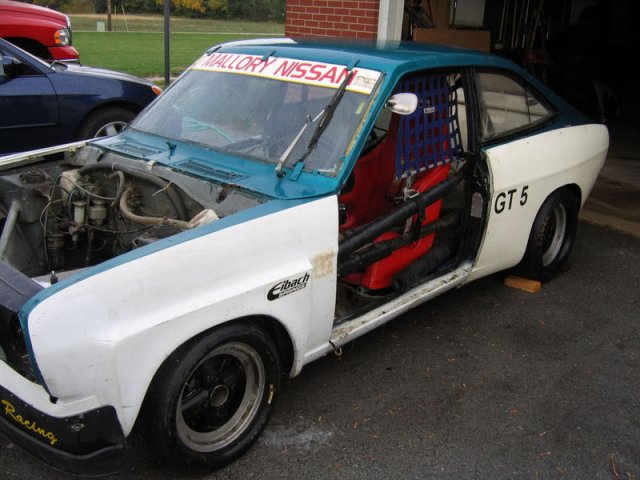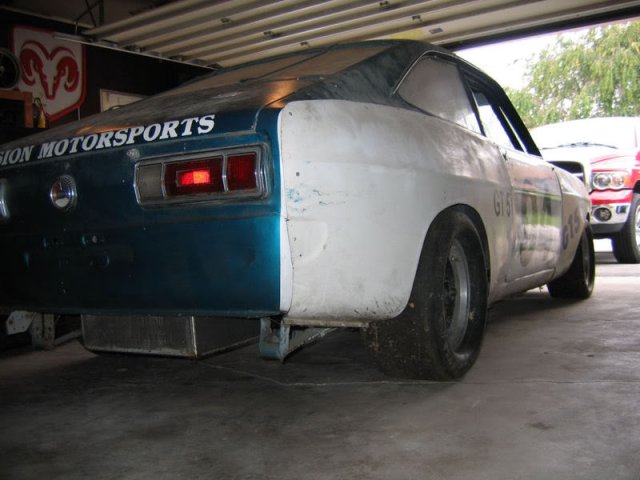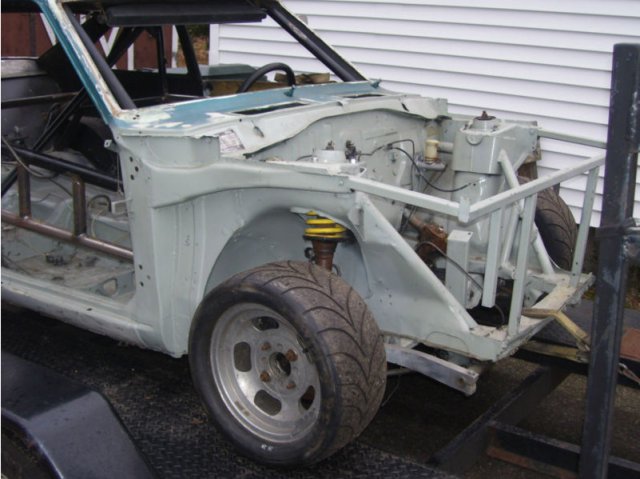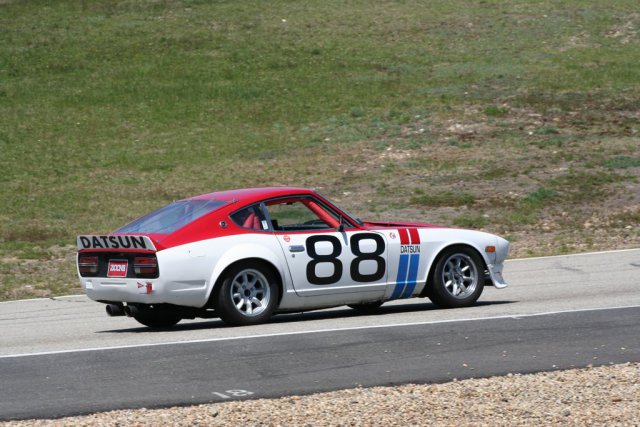-
Posts
2986 -
Joined
-
Last visited
-
Days Won
2
Content Type
Profiles
Forums
Blogs
Events
Gallery
Downloads
Store
Everything posted by z-ya
-
I'm out of running ideas here, and the problem appears to be flow, so I am switching to a stock L28 Nissan OEM pump (cast impeller). I'm also swapping the timing cover for an unmodified L28E unit. If I have time to run the flow test again I will, but I have a time trial this weekend, and they are forcasting 85F for ambient temps, so I should know by next week.
-
Still fighting cooling issues at high ambient temperatures on my road racer. I am really digging deep, and I think I am getting close. For all tests I used a 3/4" resrictor in place of a thermostat One test I have done was to check for air in the system by putting a section of clear tubing inline with the top radiator hose. Initially there was air bubbles, and some airation, but once the temp cam up a bit, and pressure built, there was no air in the water or airation happening. Tests were done at idle and up to 5000RPM. I also watched the lower hose and it stays firm for the entire test (no collapsing) So it it is not an air, or pressure problem, then maybe it is a flow issue? Here is my next test. I remove the top hose and put a hose on the thermostat housing (with a clear section to look for air) to divert the water away from the car. A shopvac hose works find for a discharge hose. Then I gravity feed the radiator inlet with a 25gal trash can. Then I ran the engine at 5000RPM and timed how long it too to empty the trash can. It took just over a minute to pump almost the entire can (until it started sucking air). So let's say it's around 20GPM. During the test I did see airation in the water coming out of the engine. I'm not sure where that was coming from, maybe an air leak around a connection somewhere. What I have been told by an expert is that 10GPH per 100HP is a good rule of thumb. My motor is 300HP. In 90F it can do almost 5 laps before the temp gets to 220F. The pump is a diesel pump with a modified L6 timing cover. Anyone know what the flow rating of the stock L6 pump is? Here is the test setup:
-
I guess I was interpreting "The three cylinders fail everything, including compression testing..."
-
Sounds like bent valves to me.
-
So I went back and looked at my notes for all the combinations I tried at the track last night. Before installing the return from the rear of the head to the thermostat housing, I had ran all combinations of thermostat, 1/2, 3/4, and 1" restictors. This was with the sensor blocking the rear coolant outlet from the head. I had only tested with the rear outlet hose installed and a thermostat (with 1/4" hole punched in it). So last night I tried the 1" restrictor (same size as thermostat when open) in place of the thermostat, and ran the engine at 2000RPM until it got up to temperature. With a window fan on the radiator, and the ambient temp around 90F, the temperature at the rear of the head never got over 185F. So it looks like with the thermostat in there, it blocks the flow from the rear of the head enough that it gets much hotter than the rest of the engine. The coolant from the rear of the head mixes with the rest of the coolant coming from the front of the head keeping the overall coolant temp low enough that by the time the thermostat opened, the rear of the head was already at 230F. I have a feeling that if I was measuring coolant temp in the thermostat housing all along, it would have been well below 180F, and I would have never seen this overheating problem until maybe it was too late. The next test and tune I will run the 1" restrictor and see what happens. On cool days I will just have to do the cardboard trick on the radiator to get the engine temps up. I think the best place to monitor coolant temp is at the rear of the head. Monitoring it at the thermostat housing doesn't give you an indication of what the hottest part of the engine is doing. I'll post results after the 7/7 test day. Thanks, Pete
-
I believe in 1973. So you can find a 1973 tach, or swap the guts from a 280Z tach into your current sensing 240Z tach.
-
They block the bypass in the block to get better overall flow through the engine. But then if you run a thermostat, you need to have a hole punched in it to prevent the pump from cavitating when the thermostat is closed. The bypass is blocked in the timing cover, which was done by BSR.
-
John, But the temp of the coolant coming out of the thermostat housing (if I believe my laser gauge on the rubber hose) is at least 40F less than what the gauge is reading at at the rear outlet on the head. At the end of our last session the dash gauge read 230F, and the thermostat outlet hose was 160F. If I point the laser gauge at the rubber hose coming out of the rear of the head, it is about 5F less than what the dashboard gauge reads. We have done all the air flow tricks including sealing gaps, ducting, going with a smaller oil cooler (sits in front of radiator). We had a fan on it, but we removed it thinking that it was blocking flow. We also have your fiberglass hood tilted in the rear about 1" to let air out of engine compartment. The radiator is a new Arizona Z unit (Griffin), which is much larger than the Datsun competition one we were running before. The behavior is the same with either radiator. Is this all due to the fact that I am measuring temp at the rear of the head (hottest part)? In the previous engine (200HP vs 300HP) we had the sensor in the stock location. Ran 180F all day. I am assuming that return from the rear of the head mixes with the cooler water coming out of the engine at the front of the head. So I could move the sensor to the thermostat housing, but I guess I want to be sure that I'm not running the head too hot in the rear. Where did you have your sensor on your race motor? Appreciate the suggestions. Pete
-
Yes, have tried the Redline product. No, I have not moved the return, but running a restrictor instead of a thermostat accomplishes the same thing. I have tried many different pressures. Running a 18-22lb one now. It is not boiling over. Raising cooling system pressure just raises the boiling point.
-
John, The problem is that the temperature continues to rise at the rear of the head. On the track it climbs to 225F, then I start heading into the pits. By the time I get to the garage, it is over 235F. I have not yet seen the temperature stabilize on hot days. This is my concern. Yes, we were doing the cardboard thing on cold days, which did help that situation. Thanks, Pete
-
I'm getting close to sorting out the vintage race car. We have done some test and tunes, and also a few vintage sprint races, but we are still facing cooling issues. If the ambient temp is below 70F, we have no overheating issues. Here is the engine build: http://forums.hybridz.org/index.php/topic/96584-road-race-enduro-l28-engine-build Cooling system details: - Griffin crossflow aluminum radiator - Diesel pump with internal bypass in block plugged - Have tried 1/2, 3/4 and 1" restrictors in thermostat housing as well as 195 thermostat will 1/4" hole punched in it. - The rear coolant port on the head is routed to the thermostat housing below the thermostat/restrictor - The temperature sender is at the rear of the head measuring the temperature of the coolant coming out the head. - The cylinders are running progressively hotter moving rearward (EGT) as expected. - Using a laser gauge the temp of the outlet hose from the thermostat housing is can be almost 40F cooler than the temp of the hose coming out of the back of the head. If the ambient temp is much over 70F, in a matter of a few laps the temp at the rear of the head can climb to 220F easily. Now on cool days, there are no issues, except that the engine doesn't really get hot enough. Now if I run a thermostat, it restricts the water coming out of the rear of the head, and keeps the rest of the engine at the thermostat temperature (remember the stock sensor location is under the thermostat). But the rear of the head will run too hot in this situation. Now if I run a restrictor, the engine will not get up to temperature on cool days. If I run the outlet from the rear of the head to the top of the thermostat housing and run a thermostat, then the engine will still probably not get up to temperature on cool days. I've read this thread a number of times: http://forums.hybridz.org/index.php/topic/59029-head-cooling-on-cylinder-5-solutions/ I'm not too keen on drilling holes between the cylinder in a priceless BSR racing E31 head. According to J.R. from BSR, they ran the sensor in the rear outlet of the head without a return back to the thermostat housing. I know this for a fact because when I got the head it had a sensor fitting installed. Suggestions welcome. Thanks, Pete
-
I've checked the oil right after shutting the engine off, and there is no measurable difference that I can see. Yes, I am running an external filter, cooler, and also using the Nismo oil pump cover with the external pickup from the pan. There is no appreciable drainback that I can see. I think what is important is to check the oil level right after shutting the engine off. I had the same problem with my build. I ended up just tapping the pan with a ball peen hammer right where the studs were hitting to give clearance. Again, check the level right after the engine is shut down. This will give you the most accurate reading. Pete
-
Nice find! I have the same pan, and you can use it with the stock dip stick after a little bending. On my engine, the low mark puts the oil level just below the windage tray. Don't fill it to the stock fill level! This will defeat the purpose of the windage tray. Pete
-
What about the valves, should I install 280Z valves? If I were to keep the L24 valves, would 40mm carbs be sufficient? I'm looking for around 180-200WHP if possible. Thanks, Pete
-
Hi Jon, The car essentially has the same suspension as described in the document attached below. In addition it also has a horizontal control rod to keep the diff from moving side to side. I' not changing anything in the suspension until I drive it first. Lots of work to do before that happens.... It's a pretty neat car with all the period correct goodies. 1200compsusp.pdf
-
I am restoring this 1200 that has a long racing history. I have log books since 1976, and it appears to have never been registered for the street. Currently in rough shape, but it's all there. Last raced in SCCA GT-5. I plan on running it in vintage and also time trials. I'm currently working on the body. I'll post more pics when it's painted.
-
Thanks for the offer, but I have one of each. If they don't check out, I'll get back to you. Too bad they don't allow turbocharged 240Zs in vintage racing. That doesn't stop me from going fast .
-
Resurrecting this project. OK, I need a backup engine for the vintage racer that we can also run in the under 2.5L run group. Plans: - Bottom end shown about with upgraded fasteners - I will use the cam (Norris 490/280), springs, and lash pads from open chamber E88 that came with this engine - Use Early E88 or E31 head, should produce around 11:1 static CR with this combination - Looking for some 40mm triples for induction (the 50mm Mikunis I run on the 13:1 CR L28 are too much for the L24?) Questions: - Should I go with L28 valves, or will the stock E31/E88 sizes be adequate for this combination? - Will 40mm triples be sufficient? Please only respond if you have actually experience building an engine similar to this one. I can speculate as good as anyone on this forum. I've attached a pic from the last vintage race we did. Thanks, Pete
-
WHP I am assuming.
-
First of all, when you installed the cam, did you verify that the timing is correct per the cam card? If not, this where I would start. Make sure it is as close to the cam mfg recommended timing and see how it performs. Then at least you have a base line to start with. Then you can try experimenting with other cam timings. What are you running for induction, carbs? Also, that is a pretty mild cam, so I wouldn't expect to see a lot more power above 5500RPM. Are you running stock springs? Did you check the spring pressure?
-
john@baddogparts.com He has all of the stainless trim for S30s
-
I'd say detonation caused the damage. Might have been a lean condition that caused the detonation, or just the fact there isn't enough octane in that west coast 91 octane fuel. I would suggest a 50/50 blend of 91/race just to be sure you have enough octane. What head and cam? Carbs, EFI? Was it dyno tuned with a WBO2 sensor?
-
John, What is the CR? What gas are you running? How much total advance? We had a problem on our last race engine where detonation was causing the gasket to blow out the side of the block on the passenger side, between 4 and 5. Switched to a 50/50 blend of 93/110 and we never again had any head gasket issues. The motor was a 10:1 flat top motor with N47 head. Pete
-
I don't quite understand the MSA listing. They say for all L6 from 70-83, which includes the F54 block (used for all turbo L28). The P79 head used for NA applications with the F54 block has the same coolant and oil passages as the P90 head that came on the turbo motors. From my experience, the Kameari gasket has holes for all head block combos. Another option is Tomei. Or, if you are not running over 15psi, just use an OEM gasket. The MSA listing may be for an old stock of 1mm Kameari gaskets. The one I installed last year worked fine for my F45/E31 combo.
-
Avoid anything engine related that is advertised as rebuilt from this seller. A freind of mine bought a rebuilt head and it still had gunk in it that had been sprayed with silver paint to look good in a photograph. It was resurfaced, and the valve job was done, but the rockers had grooves in them and the lash was not set correctly. He did give him a refund and paid for return shipping. Pete





